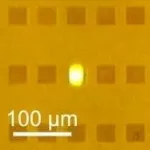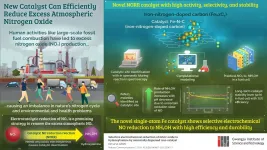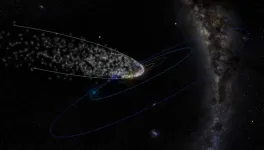Cornwall EU leave voters wanted to "take back control" and express concern about immigration
Cornwall EU leave voters wanted to "take back control" and express concern about immigration, new research shows
2021-05-20
(Press-News.org) Leave voters in Cornwall wanted to exit the EU to "take back control" and express concern about immigration - even though most said the movement of people across the continent had not caused issues for them, a new survey suggests.
A total of 56.5 per cent of people in Cornwall voted to Leave the EU in 2016, yet the area has received some of the highest levels of EU structural funding in England.
There have long been campaigns for Cornwall to have more political autonomy, but hardly anyone who took part in the research said they voted to Leave said they do so to get more power for politicians in the county.
The most frequent reason given, found in 79 responses to the survey, was the UK had lost control to the EU, and there was need to regain it.
Immigration was mentioned 77 times, very often paired with concerns about pressure on public services and loss of control over law-making. Comments included "uncontrolled immigration, loss of sovereignty" or 'being told by the EU how to run our country", "the costs of being part of the EU - could be better used in this country, immigration". People mentioned wanting a "strong" Britain, 16 of the 21 people that raised the issue of public services, also mentioned immigration, or a need to control borders.
However only six people said immigration was a problem in Cornwall, and only five said the issue was important to themselves and their families. These numbers doubled when people were asked about the impact on the UK, and 41 people gave it as a reason why they voted to Leave the EU.
The research was carried out as part of an Economic and Social Research Council Impact Accelerator project to understand why regions with high levels of European Union Structural Funding support voted disproportionately to Leave.
Dr Joanie Willett, from the University of Exeter carried out carried out three focus groups with 15 participants, as well as nine one-to-one interviews, and a questionnaire seven to ten months after the referendum, to understand the key factors behind the result. All participants had voted Leave.
The qualitative survey, which had largely open questions, was shared on social media, and email lists of business, local government, and cultural organisations. It was open for a 4-week period, and received 186 responses from Leave voters.
Dr Willett said: "Our research indicates people voted to Leave the EU because they felt like they were supporting their nation, and that would protect them, rather than a desire for stronger say in what happens in their communities. People didn't ask for political decision making to be more decentralised, but this could be a useful response to the concerns people had about having more control."
Only three survey responses mentioned voting Leave because it would allow more local control over decision-making.
Democracy was mentioned in 44 responses, membership of the EU being a waste of money in 43, wanting to create a strong Britain in 35, sovereignty in 18, the economy in 13, fishing and farming in 10, and freedom/independence/autonomy in 8. The European Court of Justice received six mentions, two people made reference to Germany and World War Two.
A total of 47 people used highly emotive language, for example: "sovereignty - not to be elected by an unelected foreign elite", but most people described their decision to vote Leave in more restrained terms. This included comments such as "Europe had too much hold on legislation"
Dr Willett said: "Many people who took part in the study wanted a strong affective economy, good public services and accessible jobs. They seem to have linked a Leave vote with expressing concerns about the association between immigration and the economy. These issues don't appear to be grounded in people's daily experiences."
INFORMATION:
ELSE PRESS RELEASES FROM THIS DATE:
2021-05-20
Untreated hepatitis C can lead to serious and life-threatening health problems like cirrhosis and liver cancer. Direct-acting antiviral therapies introduced in recent years are highly effective, with cure rates above 95%.
But most Medicaid beneficiaries with hepatitis C don't get these drugs, which cost $20,000-$30,000, due to state budget constraints.
Now, a new USC study finds that a Medicaid-Medicare partnership could cover the lifesaving medications -- and still save $1 to $1.1 billion over 25 years. Medicaid is a joint federal and state program that provides health coverage for low-income families and others. Medicare is the federal health insurance program for people 65 and older.
The study was published today in the American Journal of Managed Care.
Researchers ...
2021-05-20
For coffee drinkers, a common scenario might involve drinking an extra cup only to end up with a racing heart and a subtle reminder to themselves to cut down the caffeine. But for those who have a different thinking pattern, one that includes heart-focused anxiety, the racing heart might conclude with the fear of a heart attack and a trip to the emergency room.
It turns out young Latinx adults who experience heart-focused anxiety could be at greater risk for mental health disorders.
"We have empirical evidence that individual differences in heart-focused anxiety are related to more severe co-occurring anxiety and depressive symptomatology among a ...
2021-05-20
MSU researcher is studying, raising awareness about the role of sex in the efficacy of vaccines that make use of nanomedicine.
If there's one take-home message for the general public about the coronavirus vaccines approved in the U.S., it's that they are remarkably effective.
But Michigan State University's Morteza Mahmoudi is raising awareness about an important subtlety: The vaccines developed by Moderna and Pfizer-BioNTech appear to work slightly better for men than for women.
Both vaccines use tiny orbs, or nanoparticles, to deliver their active ingredients to cells in our immune systems. For years, Mahmoudi has been studying how and why nanomedicines -- therapies that use nanoparticles -- can affect patients differently based on their sex and ...
2021-05-20
A team of researchers at the University of Ottawa has found a way to use visible light to transform carbon dioxide gas, or CO2, into solid carbon forms that emit light. This development creates a new, low-energy CO2 reduction pathway to solid carbon that will have implications across many fields.
We talked to lead author Dr. Jaspreet Walia, Post-Doctoral Fellow in the School of Electrical Engineering and Computer Science at the University of Ottawa, and research lead Dr. Pierre Berini, uOttawa Distinguished Professor and University Research Chair in Surface Plasmon Photonics, to learn more.
Please tell us about your team's discovery.
Pierre ...
2021-05-20
COLUMBIA, Mo. -- Passports are a tangible way of showing where one has traveled, as the stamps provide a chronological order that traces an individual's journey across international borders. When an object's origins are not readily apparent, a variety of sources can be relied upon to learn more, which might include labels, sales receipts, foreign translations, oral histories, GPS coordinates and itemized personal possessions.
That documentation is an example of provenance, or the origins of an object and where it has traveled throughout history. Sarah Buchanan, an assistant professor in the University of Missouri's College of Education, is an archivist, a professional who assesses, collects and preserves various artifacts and archives them ...
2021-05-20
Our reliance on fossil fuels as a primary energy source has pushed air pollution to an all-time high, resulting in several environmental and health concerns. Among the major pollutants, nitrogen oxide (NOx) accumulation can cause severe respiratory diseases and imbalance in the Earth's nitrogen cycle. Reducing NOx accumulation is, therefore, an issue of utmost importance.
Recently, the conversion of NOx into harmless or even useful nitrogen products has emerged as a promising strategy. Particularly appealing to scientists is the reduction of NOx to hydroxylamine (NH2OH), which can be utilized ...
2021-05-20
A large-scale research project at the University of Alaska Fairbanks Geophysical Institute has revealed insight into the relationship between surface debris on glaciers and the rate at which they melt.
The work is the first global assessment of Earth's 92,033 debris-covered glaciers and shows that debris, taken as a whole, substantially reduces glacier mass loss.
The results will affect sea level rise calculations and allow for improved assessment of hazards faced by nearby communities.
"This is the first step to enable us to start projecting how these debris-covered glaciers are going to evolve in the future and how they're going to affect glacial runoff and sea level rise," said glaciologist ...
2021-05-20
May 20, 2021 - Comets that circle the Sun in very elongated orbits spread their debris so thin along their orbit or eject it out of the solar system altogether that their meteor showers are hard to detect. From a new meteor shower survey published in the journal Icarus, researchers now report that they can detect showers from the debris in the path of comets that pass close to Earth orbit and are known to return as infrequent as once every 4,000 years.
"This creates a situational awareness for potentially hazardous comets that were last near-Earth orbit as far back as 2,000 BC," said meteor astronomer and lead author Peter Jenniskens of the SETI Institute.
Jenniskens is the ...
2021-05-20
Building more homes and buildings with wood has been on the radar for years as a way to offset carbon emissions, though construction companies have been hesitant to take the material in broader use. A study at Aalto University in Finland is now the first to show that building with wood can be a sound investment.
The team analysed statistical data from real estate sales in the Finnish capital of Helsinki and two suburbs, from 1999 to 2018. Of these, timber-built homes made up 2.23% of cases. The findings show that multi-storied buildings made out of wood sold for an average of 8.85% more than those made from other materials.
Previous research has pointed to perceptions of higher costs in wood construction, ...
2021-05-20
Biologist Sasha Mendjan at the Austrian Academy of Sciences in Vienna and his team have used human pluripotent stem cells to grow sesame-seed-sized heart models, called cardioids, that spontaneously self-organize to develop a hollow chamber without the need of experimental scaffolds. This advance, which allows for the creation of some of the most realistic heart organoids to date, appears on May 20th in the journal Cell.
Previously, scientists have built 3D cardiac organoids via tissue engineering, an approach that generally involves assembling cells and scaffolds like building a house out of brick and mortar. But these engineered organoids do not have the same physiological responses to damages as human ...
LAST 30 PRESS RELEASES:
[Press-News.org] Cornwall EU leave voters wanted to "take back control" and express concern about immigration
Cornwall EU leave voters wanted to "take back control" and express concern about immigration, new research shows






